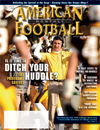Article CategoriesAFM Magazine
|
Ditching Your Huddle – With so many teams going to the no-huddle offense, should you?by: David Purdum© More from this issue Until recently, the only time most teams would dare to run plays without taking the time to huddle up to get the play call and the snap count from the quarterback was during the two-minute offense, when saving precious seconds was critical. Not any more. Today, dozens of pro and college teams have instituted full-time no-huddle offenses with the simple goal of gaining an advantage over the defense by keeping them off-guard. High school teams are even beginning to follow suit.
|
|
|||||||
| HOME |
MAGAZINE |
SUBSCRIBE | ONLINE COLUMNISTS | COACHING VIDEOS |
Copyright 2026, AmericanFootballMonthly.com
All Rights Reserved





